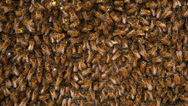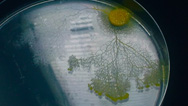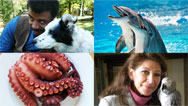Hive Mind
- Posted 11.07.12
- NOVA scienceNOW
What do bees, fish, and slime molds have in common with neurons in the human brain? Members of these communities aren't very smart on their own, but when they come together they're capable of remarkable things. Recent discoveries show that the pattern of communication within a bee colony when it is trying to choose a new home is amazingly similar to neural networks in the human brain.
Transcript
What Are Animals Thinking?
PBS Airdate: November 7, 2012
DAVID POGUE: What is intelligence, anyway? Forget about humans. Forget about anything with a big brain. Scientists are discovering a group of creatures that's forcing us to reconsider what it means to be intelligent, even what it means to think. So who are these fine specimens.
This? Are you kidding me? You dragged me out here to look at this.
ANNE PRINGLE (Harvard University): That is a wild slime mold.
DAVID POGUE: A wild slime mold.
That's right, slime mold. If looks can be deceiving, then slime mold is the master of deception. It's no ordinary single-celled creature; it's a collective of cell parts working together as one to do extraordinary things.
There is no way this thing is intelligent.
ANNE PRINGLE: But it is. I think you might be surprised. It is smart.
DAVID POGUE: Anne Pringle is an expert in fungi and slime mold at Harvard University, and she's about to show me just how smart these guys can be.
ANNE PRINGLE: All right, let's give it a go. Ready? There's your pen.
DAVID POGUE: What is this.
ANNE PRINGLE: You're going to race a maze, and the slime mold is, too, and we're going to see who does a better job.
Three, two, one, go.
DAVID POGUE: All right.
ANNE PRINGLE: Having trouble.
DAVID POGUE: Quiet.
It's not that hard, but I had to double-back a couple of times.
Done! In the time it took me to solve this puzzle your slime has done nothing.
ANNE PRINGLE: Sometimes, it's not about how quickly you do things, it's about how well you do them.
DAVID POGUE: It may take this goop over a day, but it finds the shortest path through the maze more efficiently than I did, without any mistakes or going back. All without any brain or nerves whatsoever, the slime does it by communicating across its body of thousands of cell nuclei. By working together, the collective of dumb parts can do pretty smart things.
IAIN COUZIN: This completely blows away this idea that you have to be really smart to solve problems. The intelligence emerges from the interactions among much simpler components.
DAVID POGUE: And that's just it. Slime mold, as it turns out, is just one of a growing number of creatures that scientists say possess swarm intelligence, a kind of intelligence where many individuals work together as one to do amazing things. Understanding how these organisms do it could fundamentally change the way we think about the evolution of intelligence.
IAIN COUZIN: We used to think intelligence was really associated with having one large brain, whereas now, when we look at swarming ants or bees or schooling fish, we realize you can build intelligence in other ways.
DAVID POGUE: A single fish isn't too bright, but by abiding by simple rules like, "swim close but not too close," "stay lined up," and "avoid things you don't like," the school can outsmart even the most cunning predators. And some scientists now think our brains might actually work the same way.
IAIN COUZIN: Each neuron in your brain isn't smart, yet, collectively, you're very intelligent. How is that possible? Are there parallels between these systems and how the brain operates.
DAVID POGUE: Now, one scientist thinks there are, and he has evidence to prove it.
Land ho.
Cornell biologist Tom Seeley is taking me to the secluded Appledore Island, off the coast of Maine….
TOM SEELEY (Cornell University): This is Appledore Island. Without this island, we couldn't have done this analysis.
DAVID POGUE: Wow.
…where he thinks he's discovered an alien brain to rival our own. No, it's not from another planet, it's bees.
Umm, Tom, where is my bee suit.
TOM SEELEY: Well, you won't need a bee suit here, David.
DAVID POGUE: What are you doing? Dude! You're sticking your finger in there.
TOM SEELEY: Right. You, too, can also put your finger in there.
DAVID POGUE: No, I can't.
TOM SEELEY: There you go.
DAVID POGUE: Oh my…oh, my gosh.
TOM SEELEY: There you go.
DAVID POGUE: Aaaahhhhaaaahhhh! All right.
Apparently, these bees aren't stinging me, because they're focused on finding a new place to live.
House-hunting bees are Seeley's specialty. And after 37 years of study, he's convinced that swarms like this not only make smart decisions about where to live, the way they make those decisions bears uncanny resemblance to the way decisions get made in our own brains.
IAIN COUZIN: Tom Seeley is finding that there are deep parallels with how the brain makes a decision with how the bee colony, itself, can make decisions. This is extremely important, because it's telling us something fundamental about how you can build intelligence.
DAVID POGUE: So, let me get this straight. You're saying that these bees make a decision. Dude, they're bugs.
TOM SEELEY: That's right. That's right. Collectively, they can achieve high intelligence. It's a lot like how your brain works.
DAVID POGUE: My brain? How could that be.
To understand Seeley's far-out claim, we have to look at swarming bees, like this. These 12,000 bees have outgrown their old home and need to find a new one to build their hive and raise their young.
Normally, a swarm like this would pick a roomy tree hole, but here, on Appledore Island, there aren't any trees, so Seeley can do controlled experiments with wooden nest-boxes to figure out exactly how the swarms make this decision.
To start, Seeley places two boxes out on the island, about a quarter of a mile away from the swarm in different directions. The first, labeled "yellow," is a dream home for the bees: roomy, with a small entrance to prevent predators from getting in.
TOM SEELEY: There we go.
DAVID POGUE: The second, "blue," is a fixer-upper. It has less space inside and a big entrance.
TOM SEELEY: Take out this little entrance, put in a big entrance. Okay, all set: a so-so home site.
DAVID POGUE: Back at the swarm, a few scout bees take off in search of a new home. As soon as one discovers the yellow box, Seeley's team nabs it and gently dots it with the corresponding paint color. Same goes for blue.
What happens next, I have to say, is pretty crazy.
TOM SEELEY: Each bee that finds something comes back and announces her discovery by performing these waggle dances.
DAVID POGUE: Wait, wait, waggle dances.
TOM SEELEY: Yes.
DAVID POGUE: As it turns out, the waggle dance is the way bees communicate with each other, and its discovery, back in 1946, was so astonishing that it won a Nobel Prize.
See our yellow-painted bee here ? See how every time she wiggles her head is facing the same direction? She's actually pointing her hive-mates in the direction to fly to find the yellow box.
Similarly, our blue bee is doing the same thing, but in the opposite direction, pointing the way to find the blue box. Those bees tagging behind her watch carefully so they can follow directions.
They take off, check out the real estate for themselves, get marked, and when they return, more dances, more recruits.
But the blue bees are at it, too. Now we're getting more and more painted bees back at the swarm. But that's not all. Notice how our yellow bee is doing the dance three times, while our blue bee is only doing it twice. Again, that's three times for yellow, but only twice for blue.
This last piece of waggle-speak tells us how enthusiastic they are about their sites.
Looks like yellow is picking up more recruits! And the yellow box is the better home. Will yellow win.
Wow. So how is the decision made then.
TOM SEELEY: It's a lot like an election. The bees try to recruit additional supporters to be affiliated with their site.
DAVID POGUE: And scientists thought that when enough bees waggled for a particular site, that's how the swarm would decide where to move. But then Seeley uncovered a new part of the process.
See this yellow bee here? She keeps ramming the blue bee and making that weird beep sound. It's a signal that means "stop dancing," and if she keeps it up, the blue bee will eventually stop dancing for the blue site.
The bee version of mudslinging, negative campaigning.
What Seeley discovered is that bees like this will go around using this stop signal in addition to waggle dancing, thereby campaigning for their own site and curbing the competition.
Amazingly, this process is what neuroscientists believe mirrors how decisions get made in our own brains.
JEFFERY SCHALL (Vanderbilt University): We think there is very clear evidence for the human brain that individual neurons, firing in one group at the same time, prevent firing in the other group.
DAVID POGUE: Here's how it works: let's say I'm trying to decide whether to eat cake or broccoli. Even though I'm not conscious of it, there are a bunch of neurons in my brain that are firing in favor of cake and another set firing for broccoli.
But that's not the only signal they're sending. The pro-cake neurons are also sending chemical signals to inhibit the broccoli neurons, to stop them from firing and vice versa.
This combination of positive and negative signaling is what neuroscientists call "cross inhibition," and they think it's critical to the decision-making process.
JEFFERY SCHALL: We don't have all day; we have to decide; we have to move on. Cross inhibition is critical to the process of making effective rapid choices.
DAVID POGUE: So both bees and brain cells seem to use the same strategy of positive and negative signaling to reach a decision.
IAIN COUZIN: Tom Seeley's studies of bees suggests evolution is finding the same solution to a problem. I find that mind-blowing.
DAVID POGUE: Once the decision is made, all the bees will go to one new home. The trigger is the number of bees visiting a candidate site. As soon as it hits around a hundred, those bees report back to the swarm and it's go time.
So something is happening. They're, they're getting really agitated.
TOM SEELEY: Yes, they're about to….
DAVID POGUE: Oh, my gosh! Are you seeing them peel off like that.
TOM SEELEY: Yeah, this whole swarm cluster is going to dissolve. These bees have finished making their decision. They've finished making their preparations to fly to their new home. And now they're starting to….
DAVID POGUE: I'm sorry, I can't hear you. These guys are getting so loud.
So who is the winner? Did the bees pick the best new home.
It's getting deafening.
There's 12,000 bees. Look, they're all evaporating. Look at this. All at once.
This is unreal. This is unreal.
TOM SEELEY: This is real.
It's like discovering a manuscript by Mozart, something like that. Even though the decision-making in a swarm of bees has evolved completely independently from the human brain, they've converged on the same basic design, which tells us that this is probably because this is the optimal way to do it.
Can animals solve calculus problems?
One math professor decided to find out…
…with his dog, Elvis.
The professor stood on a beach and threw a ball into the water.
Elvis ran along the beach…
…and at a certain point, swam to get the ball.
In dozens of trials, Elvis chose the route that got him there the fastest.
To figure it out mathematically, he would have to do all this: [Calculation is written on a blackboard.]
So next time you're at the beach with your dog…
…try giving him a calculus test!
Credits
What Are Animals Thinking?
- HOST
- David Pogue
- WRITTEN, PRODUCED AND DIRECTED BY
- Michael Bicks & Anna Lee Strachan
Laurie Santos Profile
- WRITTEN AND DIRECTED BY
- Joshua Seftel
- PRODUCED BY
- Joshua Seftel
Tobey List
NOVA scienceNOW
- EXECUTIVE PRODUCER
- Julia Cort
- PRODUCTION MANAGER
- Stephanie Mills
- BUSINESS MANAGER
- Elizabeth Benjes
- INTERSTITIALS PRODUCED BY
- Brian Edgerton
- ORIGINAL MUSIC BY
- Christopher Rife
- SENIOR RESEARCHER
- Kate Becker
- WHAT ARE ANIMALS THINKING? EDITED BY
- Daniel Gaucher
- PROFILE EDITED BY
- Dan Madden
- PROFILE PRODUCTION SUPERVISOR
- Jill Landaker Grunes
- PROFILE ASSOCIATE PRODUCER
- Catherine Bright
- ARCHIVAL RESEARCH
- MInna Kane
Adam Talaid - CAMERA
- Ben McCoy
Thomas Danielczik
Greg Andracke
Bruce Nixon
Austin De Besche
Keith Walker
Bruce Anderson
Fulvio Paolocci
Christian Stolz
Tony Forma
Kevin Bond
Jason Longo
Bruce Nixon - SOUND RECORDISTS
- Ty Chu
John Osborne
Everett Wong
Rick Albright
Angelica Marin
Thomas Skarda
Steve Crell
Steve Bores
Michael Karas
Rick Albright
Rafael J. Perez Veve - ADDITIONAL MUSIC
- Scorekeeper's Music
- ANIMATION
- Handcranked Productions
- ONLINE EDITOR AND COLORIST
- Jim Ferguson
- AUDIO MIX
- Heart Punch Studio, Inc.
- ADDITIONAL EDITING
- Jawad Metni
Rob Chapman - ADDITIONAL CAMERA
- Steve Becker
- ASSISTANT CAMERA
- Jimmy Jay Frieden
- MEDIA MANAGER
- Brian Chamberlain
- ASSISTANT EDITOR
- Steve Benjamin
- POST PRODUCTION ASSISTANT
- Olaf Steel
- PRODUCTION ASSISTANTS
- Jack McKenzie
Amanda Armour
Ernesto Gomez Gomez - ADMINISTRATIVE SUPPORT
- Kim Perkins
- ARCHIVAL MATERIAL
- Getty
Pond5
Corbis
iStockphoto
Shutterstock
Framepool
B. F. Skinner FoundationLibrary of Congress, Prints & Photographs Division
Official Navy Photo, NAWCWD China Lake
Reto Stockli, NASA Earth Observatory
U.S. Navy - SPECIAL THANKS
- Lola ya Bonobo
Lynne Boddy
Serita Frey
François Peaudecerf
Karen Alim
Gabriel Amselem - ADVISORS
- Sangeeta Bhatia
Charles Jennings
Richard Lifton
Neil Shubin
Rudy Tanzi - NOVA SERIES GRAPHICS
- yU + co.
- NOVA THEME MUSIC
- Walter Werzowa
John Luker
Musikvergnuegen, Inc. - ADDITIONAL NOVA THEME MUSIC
- Ray Loring
Rob Morsberger - POST PRODUCTION ONLINE EDITOR
- Spencer Gentry
- CLOSED CAPTIONING
- The Caption Center
- MARKETING AND PUBLICITY
- Karen Laverty
- PUBLICITY
- Eileen Campion
Victoria Louie - NOVA ADMINISTRATOR
- Kristen Sommerhalter
- PRODUCTION COORDINATOR
- Linda Callahan
- PARALEGAL
- Sarah Erlandson
- TALENT RELATIONS
- Scott Kardel, Esq.
Janice Flood - LEGAL COUNSEL
- Susan Rosen
- DIRECTOR OF EDUCATION
- Rachel Connolly
- DIGITAL PROJECTS MANAGER
- Kristine Allington
- DIRECTOR OF NEW MEDIA
- Lauren Aguirre
- ASSOCIATE PRODUCER
- POST PRODUCTION Patrick Carey
- POST PRODUCTION EDITOR
- Rebecca Nieto
- POST PRODUCTION MANAGER
- Nathan Gunner
- COMPLIANCE MANAGER
- Linzy Emery
- DEVELOPMENT PRODUCERS
- Pamela Rosenstein
David Condon - COORDINATING PRODUCER
- Laurie Cahalane
- SENIOR SCIENCE EDITOR
- Evan Hadingham
- SENIOR PRODUCER
- Chris Schmidt
- SENIOR SERIES PRODUCER
- Melanie Wallace
- MANAGING DIRECTOR
- Alan Ritsko
- SENIOR EXECUTIVE PRODUCER
- Paula S. Apsell
NOVA scienceNOW is a trademark of the WGBH Educational Foundation
NOVA scienceNOW is produced for WGBH/Boston
This material is based upon work supported by the National Science Foundation under Grant No. 0917517. Any opinions, findings, and conclusions or recommendations expressed in this material are those of the author(s) and do not necessarily reflect the views of the National Science Foundation.
© 2012 WGBH Educational Foundation
All rights reserved
Image
- (bees)
- © WGBH Educational Foundation
Participants
- Iain Couzin
- Princeton University
- Anne Pringle
- Harvard University
- Jeffery Schall
- Vanderbilt University
- Tom Seeley
- Cornell University
Related Links
-

What Are Animals Thinking?
Probe animal morality, the "swarm intelligence" of a beehive, the amazing navigation talents of pigeons, and more.
-

The Waggle Dance
Watch David Pogue shake his money maker like a honeybee.
-

Slime Mold Smarts
Slime molds may be brainless, but they aren't stupid.
-

How Smart Are Animals?
Dogs, dolphins, parrots, and even octopuses (mere mollusks!) may be smarter than you think.



